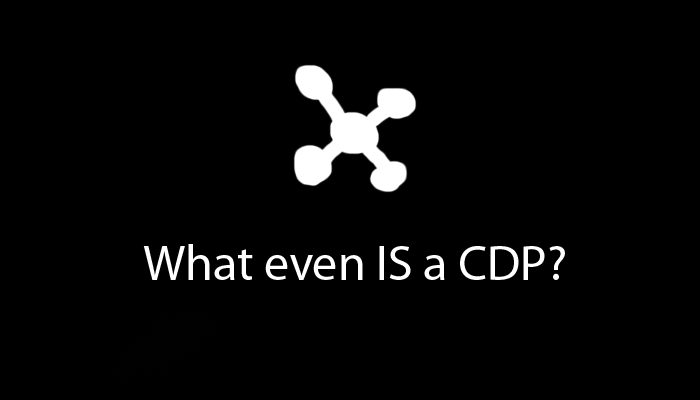I’m going to come right out and say it. When I look at CDPs I think… what am I missing here? I understand why they exist and what they do (at least SAY they do) – and, hell, at Blue Acorn iCi I am part of a lot of vendor evaluations. They’ve been around for over a decade, but something still nags at me. There are hundreds of CDP vendors. Hundreds. How are there so many? The sales pitch is the same: consolidate data, use said data to create audiences for personalization and deployment to do real-time targeting. Sprinkle the word “Edge” and “Composability” into a few sentences and baby – you got a stew going!
As one who has been doing this analytics stuff for a while… why doesn’t any of this feel new or novel? Historically, we just called it something else, right? So is a CDP something that’s truly different? Does composability really deserve to be its own product? Is it just a collection of stuff that already existed crammed into another 3 letter abbreviation? I have some thoughts, but let’s do some cross-checking by consulting the internet!
Table of Contents
What does a CDP do?
My first stop is CDP.com to see what they (and clearly ChatGPT) have to say. A CDP:
- Combines data from a lot of different sources
- Plugs into other tools
- “Democratizes data” because it’s now in 1 place…?
- Uses the data to personalize and target via marketing
Okay, so historically we solved the whole data consolidation/combination thing with BI tools… which collect data from a bunch of different sources. We’ve had data integrations for decades, but maybe not at the right scale. “Data democratization” is making the case that having data in 1 location improves the likelihood of organizational adoption. BI tools try to solve for this and usually you just end up with N+1 reporting tools, but that’s not the tool’s fault. Finally, activating the data/customer profiles to do personalization and marketing stuff. That’s a good value prop, but it’s also not new or novel.
The CDP Institute lays out specific criteria to classify a CDP. The software has to be packaged (have to have something to sell). It has to unify customer data (primary keys are new and exciting). Finally, it has to be accessible to other systems. So it’s an analytics platform but it also isn’t. It’s a BI tool but also isn’t. It’s a content targeting tool but also isn’t. It toes the border of all of these tools (and more!) without committing to a side. Better yet, you can buy your way out of conversations about which analytics tool should manage this stuff. It’s basically the Switzerland of MarTech.
Can we get more specific?
I have to be missing something because my source material says they do literally everything without giving a practical explanation of what they do. I could already do personalization stuff with Adobe Target. I’m already defining and stitching personal identifiers in Adobe Analytics, integrating offline and CRM data, and creating audiences and segments. The missing piece is just hooking it into these other platforms in real-time. So THAT is a CDP? Is that the basis on which hundreds of these companies exist and charge these massive licenses? It’s literally just API connectivity? Let’s see what a CDP vendor says: A CDP is not a personalization tool. Wait a second, CDP.com just told me it was! Hold up… EVEN YOU JUST TOLD ME IT WAS!
Let’s look at Oracle’s explanation. This includes a video of David Raab, the person who coined the term, explaining a CDP. In the video, he has this to say:
[A CDP is] pulling the data in from all sources unified. It’s storing it someplace separate, not just reading it in real-time from the source systems, and [that] basically doesn’t work for this particular application.
Okay, hang on. Does that mean it can’t be composable? You know, because it’s not storing/duplicating the data someplace else. This is coming from the person who invented this stuff. The Oracle article also has a nice little list of stuff CDPs do:
- Connecting online to offline
- Customer segmentation
- Customer personalization
- Lead scoring
- Retargeting and lookalike advertising
- Product recommendations
- Optimizing conversion rates
- A/B testing
- Omnichannel automation
- Improved email deliverability
- Better and more online reviews
- Improve customer lifetime value (CLV)
So you’ve got these teams building a tool that’s trying to be good at literally everything (hey, there’s personalization again). I’m tired, boss.
My interpretation of CDPs
So what even IS a CDP? It’s a buffet of features that honestly should be directly integrated with existing analytics platforms. It’s a collection of stuff we could do before, but a more real-timey and customer stitchy. And for the sole reason that analytics platforms didn’t want to share data – we have hundreds of these platforms. The basis of the AEP Mindset post is that are are coalescing these “features” of a CDP into long-overdue updates to our analytics platforms. I don’t think doing CDP work is a discipline, much like testing and analysis is a discipline.
Time to poke holes
So you’re saying analytics tools should be able to take data from any platform, resolve customer identity, and then send that data back out to marketing platforms. So now I have like 6 analytics tools that all have this capability/requirement instead of 1.
YES… but that’s not how it will work. There will be 1 or 2 that are really good at it (Adobe, for instance). Just use that and most platforms won’t bother baking in these features. They shouldn’t have to.
But there’s processing cost associated with that. You can’t just deploy that feature without scaling servers and charging separately for the set of features.
That’s right! Figure out how to bill appropriately.
Analytics tools don’t usually natively bring in a lot of these different data sources. They like to keep you in their ecosystem.
This was true like 5 years ago and is not true today. Let’s pretend it isn’t true, though. Shouldn’t we expect them to modernize? Can we do that without creating a new 3 letter abbreviation and turning it into a totally different platform? Why not name them after what they do instead of the parts they’re built with? I’ll start:
- Customer Journey Analytics
- Audience Manager
- Journey Optimizer
I’m just spit-balling here.
My point is that this was definitely an issue in the days before AEP, Piwik, Google Cloud, or Salesforce’s new features. CDPs were built, made money, and convinced the market to adapt. They adapted. Can we finally move on and stop packaging these features in their own ecosystem? Give it the “cloud” and “big data” treatment. Support for this stuff in major enterprise software is table stakes.
Final Thoughts

This feels like a hot take and I don’t want to push the “Publish” button because I’m confident that someone will swoop in and tell me about how wrong I am. I tried to do my diligence. You have NO IDEA how many horrendous articles I had to read – how many atrocious architecture diagrams I suffered through. Maybe that’s the problem – the CDPs I’ve implemented just didn’t quite take me to the point where I realized this was an incredible thing. Part of creating an incredible product is being able to clearly and concisely state its value proposition. CDP vendors are too busy fighting over composability to think about this.
I want the merging of customer data to be a novel concept – or audience-building… with just more data… to be something groundbreaking. Or real-time targeting of this stuff – that is a great idea. It’s been done, but it’s also a great idea. Do we really need to have hundreds of disparate platforms to do this? The existence of so many CDPs means there are tens of thousands of jobs that are literally bound to this idea; and that’s really scary. It also explains some of the FUD in this industry.
David Chan wrote a post about a year ago about whether CDPs are even necessary (to be clear, he’s a “big fan of CDP”). He’s right that you can brute force any of its use cases without a CDP. That sure sounds a lot like my article, right? I think that was true before platforms like AEP and Salesforce decided to finally introduce CDP’ey features. There was a place for CDPs years ago for some organizations (even though only 58% say they get value out of their CDP – and I’d challenge that as a highly-inflated number). It’s not because its features don’t create value. If you do it right, they can. At this point in the game, we need to move away from selling platforms that dabbles in every area of activation and focus on integrating this collection of features into existing, mature products.
And yes, there will be a teeny tiny fraction of a market that will need its own special, standalone solution to handle an incomprehensible amount of data. For everyone else, let’s go back to just calling it an analytics platform.
